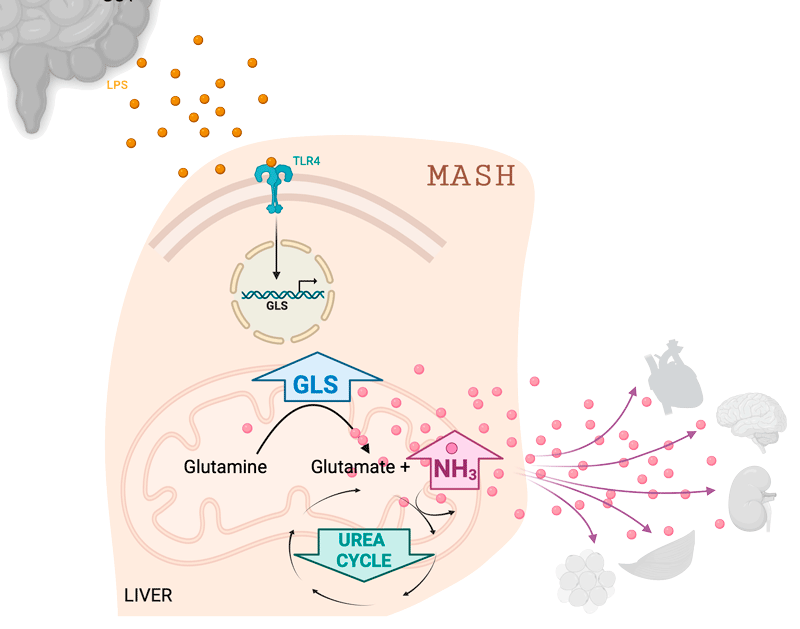
2024/07/11
Untangling the mechanisms underlying the progression of Metabolic-Associated Steatotic Liver Disease (MASLD)
Metabolic liver disease (MLD), the most common liver disease with a global prevalence of 30%, can progress to metabolic-associated steatohepatitis (MASH), characterized by fat accumulation and liver inflammation, increasing the risk of fibrosis, cirrhosis, and liver cancer.
A new study, published in the journal Metabolism, provides further evidence on the regulatory mechanisms of the liver enzyme glutaminase 1 (GLS) in metabolic liver disease, highlighting its role in ammonia accumulation in the liver, a feature of steatohepatitis.
A collaborative international study from The Liver Disease Laboratory, led by Dr. Malu Martínez-Chantar at CIC bioGUNE – member of BRTA – and CIBEREHD, and the “Ramón y Cajal” and Ikerbasque Researcher Teresa Cardoso Delgado from the Biobizkaia Health Research Institute and colleagues from CIMUS, ISPA, CINN, IUOPA, UPV/EHU and UCL at the United Kingdom was published in the journal Metabolism.
This study revealed potential mechanisms underlying the upregulation of the liver enzyme glutaminase 1 (GLS) in steatotic liver disease and highlighted the important role of GLS in driving liver ammonia accumulation, a hallmark of steatohepatitis.
Metabolic-associated steatotic liver disease (MASLD), previously known as non-alcoholic fatty liver disease (NAFLD), is the most common type of chronic liver disease worldwide with a 30% global prevalence. Metabolic-associated steatohepatitis (MASH), is a progressive form of MASLD, characterized by marked fat accumulation in liver cells (steatosis), dead and dying liver cells (ballooning and degeneration), and liver inflammation. Patients with MASH have a higher risk of liver-related morbidity and mortality and metabolic comorbidities, such as liver fibrosis, cirrhosis, liver cancer, and cardiovascular disease. Understanding the mechanisms and drivers underlying the progression of simple steatosis to MASH is important to recognize at-risk patients and potential therapeutic targets.
In this study by Maria Mercado-Gómez et al., the authors have shown that the enzyme glutaminase 1 (GLS), which converts glutamine to glutamate and the toxic byproduct ammonia, is a hallmark of MASH in liver biopsies of preclinical models and patients with MASLD. Ammonia has been suggested to be a pathogenic factor potentially accounting for MASLD-related multiorgan dysfunction and disease progression. Importantly, diminishing hepatic GLS in pre-clinical models of MASH is sufficient to reduce hepatic ammonia, suggesting the important role played by this enzyme in the pathogenic accumulation of hepatic ammonia underlying MASH.
Moreover, the authors have described that lipopolysaccharide (LPS), large molecules found in the membrane of some types of bacteria, can increase GLS expression in the liver. In contrast, the pharmacological inhibition of the LPS receptor, toll-like receptor 4 (TLR4), hampers GLS increase. Overall, these results agree with a large amount of literature pinpointing that the intestinal microbiota and bacterial products can, directly and indirectly, affect the liver through various mechanisms, leading to a wide variety of liver diseases, including MASH.
To fulfill this project, it was fundamental the financial support provided by the Ministry of Science, Innovation, and Universities from the Government of Spain (AEI), the Ikerbasque Foundation, Foundation La Caixa, Carlos III Health Institute, the Departments of Education of the Basque Government, the Gilead Sciences International Research Scholars Program and CIBERehd.
Reference: Maria Mercado-Gómez, Naroa Goikoetxea-Usandizaga, Annarein J C Kerbert, Leire Uraga Gracianteparaluceta, Marina Serrano-Maciá, Sofia Lachiondo-Ortega, Rubén Rodriguez-Agudo, Clàudia Gil-Pitarch, Jorge Simón, Irene González-Recio, Marcos F Fondevila, Pablo Santamarina-Ojeda, Mario F Fraga, Rubén Nogueiras, Javier de Las Heras, Rajiv Jalan, María Luz Martínez-Chantar, Teresa C Delgado. The lipopolysaccharide-TLR4 axis regulates hepatic glutaminase 1 expression promoting liver ammonia build-up as steatotic liver progresses to steatohepatitis. Metabolism. DOI: 10.1016/j.metabol.2024.155952. Online ahead of print.
About CIC bioGUNE
The Centre for Cooperative Research in Biosciences (CIC bioGUNE), member of the Basque Research & Technology Alliance (BRTA), located in the Bizkaia Technology Park, is a biomedical research organisation conducting cutting-edge research at the interface between structural, molecular and cell biology, with a particular focus on generating knowledge on the molecular bases of disease, for use in the development of new diagnostic methods and advanced therapies.
About Ikerbasque
Ikerbasque - Basque Foundation for Science - is the result of an initiative of the Department of Education of the Basque Government that aims to reinforce the commitment to scientific research by attracting, recovering and consolidating excellent researchers from all over the world. Currently, it is a consolidated organization that has 290 researchers/s, who develop their work in all fields of knowledge.
About BRTA
BRTA is an alliance of 4 collaborative research centres (CIC bioGUNE, CIC nanoGUNE, CIC biomaGUNE y CIC energiGUNE) and 13 technology centres (Azterlan, Azti, Ceit, Cidetec, Gaiker, Ideko, Ikerlan, Leartiker, Lortek, Neiker, Tecnalia, Tekniker y Vicomtech) with the main objective of developing advanced technological solutions for the Basque corporate fabric.
With the support of the Basque Government, the SPRI Group and the Provincial Councils of the three territories, the alliance seeks to promote collaboration between the research centres, strengthen the conditions to generate and transfer knowledge to companies, contributing to their competitiveness and outspreading the Basque scientific-technological capacity abroad.
BRTA has a workforce of 3,500 professionals, executes 22% of the Basque Country's R&D investment, registers an annual turnover of more than 300 million euros and generates 100 European and international patents per year.
See a large version of the first picture





